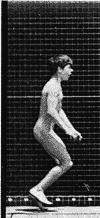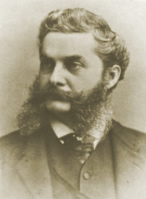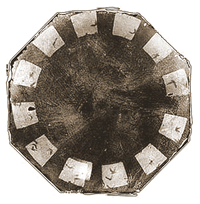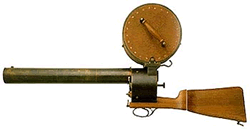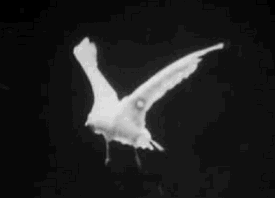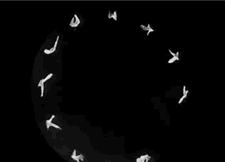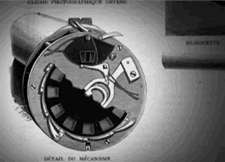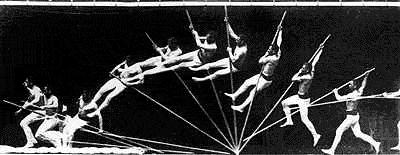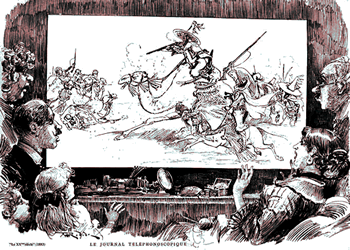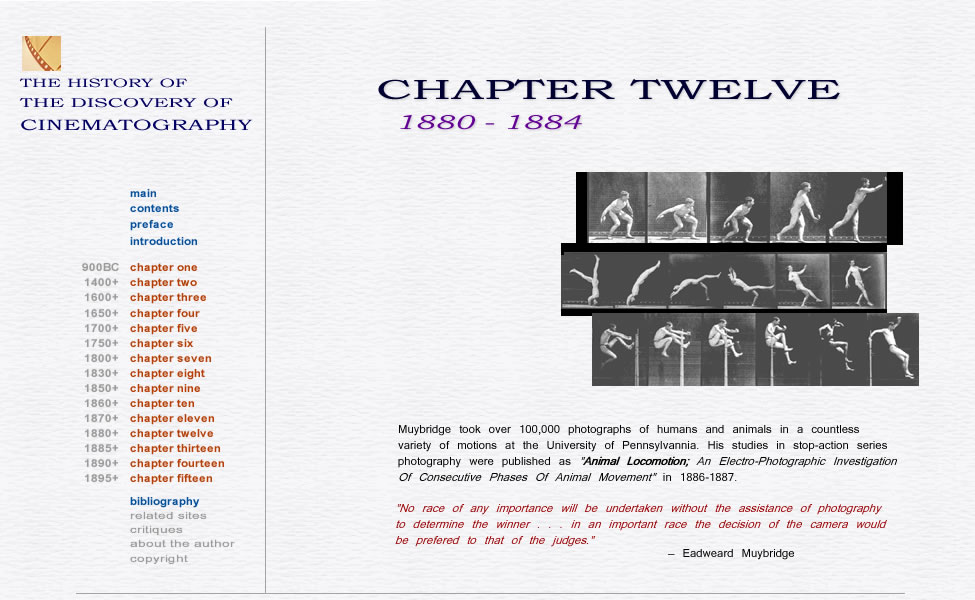 |
| |
|
|
|
| |
|
|
|
| |
|
|
|
| |
1880
CHARLES-EMILE REYNAUD (1844 - 1918) |
|
|
| |
Reynaud demonstrated his
Praxinoscope which was electrically driven. The Praxinoscope
was a device quite similar to that of the Zoetrope in
that it recreated an animated effect. Posed still photographs were used
and viewed through a window as a mirror reflection. Photographs were shown
in sequence. |
|
| |
|
|
|
| |
|
|
|
| |
|
|
| |
|
|
| |
1880
JOSEPH BOGGS BEALE (1841 - 1926)
The most famous of American Lanternists, Beale saw his first lantern
show as a child. In his professional career he delivered a complete
repertoire of shows including themes such as Christmas, historical,
political, great literature and religion. Beale witnessed the decline
of the magic lantern as a premiere entertainment spectacle as the
twentieth century approached, and the cinema with it. Today, with
the resurgence of the magic lantern, lanternist enthusiasts and
professionals around the world can be found performing in all types
of venues. Terry Borton is one professional lanternist who honours
the work of Beale by centering his entire show on the themes and
work of Beale. The American Magic Lantern Theatre
is the country's only authentic 1890's show. Visit
The American Magic Lantern Theatre Here. |
|
| |
Joseph
Boggs Beale |
|
|
| |
|
|
| |
|
|
| |
|
|
|
| |
|
|
|
| |
1881
EADWEARD JAMES MUYBRIDGE (1830 - 1904) and ETIENNE-JULES MAREY (1830 -
1904) |
|
| |
These men unite in Paris
to begin collaborating in the study of motion. Muybridge had by now, constructed
a series of pictures depicting motion by the use of a single camera. He
then alongside Marey, shows these photos using a Uchatius lantern and
could possibly have acquired picture-motion this way. The Zoopraxiscope
has been, albeit rarely, called the Zoogyroscope as well.
One such instance was a write-up from in Cassiers‚€™s Magazine
of 1881 in which we read ; |
|
| |
|
|
|
| |
"Readers
may remember that a good deal of interest was excited here and elsewhere
not very long ago, by the publication of photographs and engravings illustrating
the various motions of a trotting horse. Since these instantaneous photographs
were taken, an instrument called the ZOOGYROSCOPE has
been invented for the purpose of imparting something of a lifelike character
to the pictorial representation in question. Mr. Muybridge, the inventor,
describes it as a circular glass bearing a series of photographs of the
animal to be represented in motion. As the glass is turned, the photographs,
which ar successively illuminated by an oxy-hydrogen lantern, throw upon
the screen a single, continuous, yet ever-changing picture, which is considered
to be so admirable an imitation of the ‚€œreal-live‚€Ě horse, that nothing
but the clatter of the hoofs and the breath of the nostrils is wanted
to render the delusion complete. The Zoogyroscope can,
it is scarcely necessary to add, be applied to photographs of other animals
beside the horse.‚€Ě |
|
| |
|
|
|
|
|
|
|
| |
1882
ALBERT LONDE (1858 - 1917) |
|
| |
A photographer by profession,
Londe worked at a Paris hospital (La Saltpetriere) in the neurological
department using photography to study epileptic seizures. Londe designed
and built a camera which had nine lenses which were tripped by electro-magnetic
energy (a battery) and the use of a metronome to time the release of the
shutters. This camera took in rapid succession, photographs on a glass
plate. Not known as a photographer who added to the further study of stop-action
series photography, Albert Londe must be acknowledged for his
overall work within medicine using photography. He would use his talents
in the study of animal movement and the action of waves. [SEE
ALSO LONDE 1891] |
|
| |
|
|
|
| |
|
|
|
| |
1882
ROBERT R. BEARD (1856 - 1932) |
|
|
| |
Early in his working years
Beard caught on with a manufacturer of magic lanterns and began to learn
the craft. Lanternists relied heavily on oxygen tanks to provide fuel
for illumination and Beard came up with a regulator that was automated
for use with the oxygen cylinders. R. R. Beard Ltd. came into existence
this year to manufacture the regulators. Beard went on to invent what
he called an Eclipse Slide Carrier which allowed ease-of-use when exchanging
slides in the lantern. |
|
| |
|
|
|
| |
|
|
|
| |
1882
ANTOINE LUMIERE (1840 - 1911) |
|
|
| |
The Lumiere family was
astute and prolific scientists. They introduced landmark inventions in
the field of photography and Antoine, father of the more famous Lumiere
brothers, founded Lumiere and Sons and manufactured photographic gelatin
dry plates in Lyons. In 1883 the company made it's first filmstrip, a
collodion stripping film invented by Georges Balagny. In 1887 the Lumiere's
expanded to begin making roll films and printing papers. They also pioneered
the investigations into colour photography and colour films. The Lumiere's
second major invention was the first commercially successful Celluloid-film
motion picture camera-projector. It was known as the
Cinematographe, and made its first public showing in
December 1895 in Paris. |
|
| |
|
|
|
| |
|
|
|
| |
|
|
| |
|
|
| |
1882
√‰TIENNE-JULES MAREY (1830 - 1904)
Marey designs and builds what was to become the world's first portable
motion picture camera. He designs and builds a
camera in the shape of a 'rifle' which is used to take
12 frames of birds in flight. The 'Chronophotographs'
as they were called, were taken at a speed of 1/720th of a second.
Marey called his "rifle" a Fusil Photographique. |
| |
|
|
|
Chronophotography
consisted of exposures made using plates of glass (left),
or on thick strips of primitive film. In the case of the film, Marey
was able to use his 'rifle' camera (right) to make multiple
exposures. His camera also circumvented the cumbersome method of
Muybridge's large stationary cameras. A physiologist, Marey became
fascinated with the problem of analyzing how insects, birds, animals
and humans move. |
|
Disk
Used In Marey's Fusil Photographique |
|
Marey's
Fusil Photographique 'Rifle' |
| |
|
(Marey
Rifle image thanks to Russell Naughton) |
| He created
several methods of obtaining time and motion recordings by means
of mechanical or pneumatic devices attached directly to the subject,
which activated a pen resting on a band of moving paper. Marey's
meeting with Muybridge in 1881 convinced him of the value of photography
for his work. He went on to invent a number of repeating-shutter
cameras most of which recorded a series of images on a single plate,
allowing a flow of the movements to be analyzed. His various devices
and inventions were the foundation of a number of motion
pictures, slow motion and high-speed cameras and projectors
developed, and commercially exploited by others. His sequence pictures
were at least as valuable and influential, as those of Muybridge
in establishing the modern techniques of physiological movement
analysis. |
| |
|
|
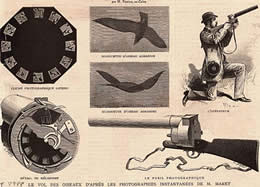 |
In 1882 Marey gave
up on his Chronographic work, moving to Chronophotography.
His preference to follow the movement of birds from one perspective
(as opposed to the Muybridge method of twenty-four [albeit slightly]
perspectives), led to the Fusil Photographique
or photographic 'rifle'. Through this method Marey was
now capable of moving with the bird in air, as in panning. Each
phase of movement was exposed on one gelatine plate in the camera.
Marey actually found the smaller the creature, the better the response.
Larger subjects like people and horses tended to be over-lapped
on the plate due to the shorter intervals between exposures. However
this difficulty was overcome in human forms by the black suit/striped
appendages.
The Illustration
to the left is entitled "Flight of
the birds according to the instantaneous photographs of Mr. Marey",
From 1882 |
Illustration
Showing The Fusil Photographique |
|
|
How
Marey's Bird Would Have Looked Using His Fusil Photographique
(right) |
|
| |
|
Animation
Of The Twelve Frames |
| |
| |
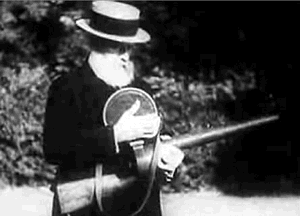 |
FUSIL
PHOTOGRAPHIQUE IN ACTION
Marey's mobile camera
allowed for the birds to be followed more easily than
a stationary camera. He therefore shared the idea of the
Janssen 'revolver'. Simply by aiming his gun
at the flying birds, Marey was able to place twelve exposures
along the outer edge of the plate (above & below).
The very end of the
barrel could be moved in or out thereby providing focus.
At the bottom of the end of the barrel [centre of
the gun], housed the magazine containing the gelatine
plate.
In front of the plate
was another disk, opaque, with twelve shutters, and in
front of that disk, one more opaque disk with only one
opening. |
| Footage
(above) of Marey's Fusil Photographique being used
to create chronophotographs of birds. The art of cinematography
illustrating one of the important steps in it's own discovery. |
This
gentleman (left) is using the rifle with disk
option as opposed to the film magazine option. Notice
that he removes the magazine and places it over his
shoulder. An image of the Fusil Photographique (above)
shows the camera with the film magazine loaded.
|
| |
|
| |
|
|
The film (above) of the Fusil Photographique
in use was not taken in 1882, but at a later date. By
firing the trigger, all three disks moved with the help
of a clocked mechanism (see below).
These photographs of birds were to this point in his
experiments, the most exciting to date.
The rifle's portability allowed a new form of perspective
to be captured while keeping the subject within the frame.
This was soon to be known as 'panning', which quickly
caught on and in the early twentieth century became a
staple of filmmaking. |
|
| Although
Le Prince, the Lumieres, Edison and Melies shot their original
experimental films with stationary cameras, Marey's rifle
allowed motion from both camera and subject, thereby enhancing
this sense of 'movement'. Panning would be incorporated
into cinematography very soon. |
What
the bird on the disk (above) looked like when
projected.
|
| |
|
|
|
|
Marey's
sequential photography was as important as the work of
Muybridge, in establishing the modern techniques of physiological
movement analysis.
Marey preferred to work with smaller animals in studying
their movements.
Marey and Muybridge had met a year earlier in1881. |
Eleven
of twelve birds (above left) on the disk. Clocked
shutter mechanism (above right) showing disk. |
|
|
|
|
|
|
| |
|
|
|
| |
|
|
| |
|
|
|
| |
|
|
|
| |
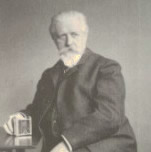 |
1882
OTTOMAR ANSCHUTZ (1846 - 1907)
Working
at a Zoo in Poland to photograph animals in motion, Anschutz uses
a hand sized camera he fitted with a focal-plane shutter. It‚€™s ability
to take extremely rapid exposures ( 1/1000th of a second) enables
Anschutz to do educational work in motion. He takes photographs
of marching troops, gymnasts and jumping horses. In 1882 Anschutz
began taking instantaneous photographs. It wasn't until two years
later that he became better known for his photographs of birds in
flight. They reached fame because of their brilliant clarity and
sharpness of detail. The redesigned camera became known as the Goerz/Anschutz
camera. |
| Ottomar
Anschutz |
|
|
|
| |
|
|
|
| |
|
|
| |
|
|
|
| |
|
|
|
| |
1882
EADWEARD JAMES MUYBRIDGE (1830 - 1904) |
|
|
| |
Muybridge states with
all enthusiasm regarding horse races, that "no
race of any importance will be undertaken without the assistance of photography
to determine the winner . . . . . In an important race the decision of
the camera would be preferred to that of the judges." Six
years later it came true. Ernest Marks, official photographer for the
Plainfield Racing Association in New Jersey, provided positive photographs
within minutes of the finish. |
|
| |
|
|
|
| |
|
|
|
| |
1882
CHARLES-EMILE REYNAUD (1844 - 1918) |
|
|
| |
Reynaud presents another
projector called the Lamposcope containing a disk with
posed images on the outer rim. |
|
| |
|
|
|
| |
|
|
|
| |
|
|
| |
1882-1883
√‰TIENNE-JULES MAREY (1830 - 1904)
Marey set up shop at the Physiological Station at Bois de Boulogne
near Paris. He had a 36-foot long studio-type building constructed
for him that was completely open in the front. It was 13 feet high
with the interior completely blackened with cloth to allow a human
actor also in black to be photographed. The actor had white stripes
lined down each appendage facing the camera. Marey‚€™s Chronophotogaphy
technique took consecutive photographs on one singular gelatin plate. |
| |
|
| |
| |
|
| Co-father
of Motion Study Analysis, √‰tienne-Jules Marey,
was a physician, physiologist, inventor and photographer. He gave
us the Chronophotograph, Sphygmograph
and Odograph to name only a few of his many contributions
to science. Here (above) is an example of Marey's stop-action
series photography, which he took with his Fusil
Photographique, or photographic "rifle". Marey also designed
a "pistol", which he used to photograph the movement of animals,
as Muybridge did. This Chronophotograph was taken
in 1882. |
|
|
| |
|
|
| |
|
|
|
| |
|
|
|
| |
1883
B. J. KILBURN ( - ) |
|
|
| |
Another ‚€˜gun‚€™ camera is
designed, built and patented, this time by Kilburn. |
|
| |
|
|
|
| |
|
|
|
| |
1883
THOMAS ALVA EDISON (1847 - 1931) and EADWEARD JAMES MUYBRIDGE (1830 -
1904) |
|
| |
The first of two known
meetings between these two men (the second is in 1888) to consider the
combining of Muybridge‚€™s Zoopraxiscope for vision, and
Edison‚€™s Phonograph for audio, thereby providing the
initial steps needed to produce a complete episode of natural motion with
sound. |
|
| |
|
|
|
| |
|
|
|
|
|
|
| |
|
|
|
| |
1883
ALBERT ROBIDA (1848 - 1926)
In 1883 Albert Robida
published the first of a series of three books in futuristic
literature. It was called 'Le Vingtième Siècle'
(The Twentieth Century). Set in the year 1952, it tells
the story of young Hélène, her struggles through
life, and the marvels of the future.
In this novel Robida describes his Telephonoscope,
which may likely have been taken from a combination of contemporary
and near-inventions of the day. He conveys the possibility of
transmitting both sight and sound in real-time, anywhere.
Although not an entry that portrays any contribution to cinematography
directly, we thought it important to mention Robida if only
for the simple fact that he saw the potential of motion pictures
combined with sound, and told us about it before we
saw it ourselves. |
|
| |
Illustration
'Le Journal Telephonoscopique' (above) By Albert Robida,
1883. |
| |
|
| Robida
was a visionary, artist and writer. In 'Le
Vingtième Siècle' he depicts the
future of fluid motion combined with sound, through electric transmission,
simultaneously and all in one instance twenty-fours hours a day,
365 days a year. In his description of his Telephonoscope,
Robida gives us television, video, video-conferencing, and email
all rolled into one including the cable news channels. Robida's
other entries in his series were 'La Guerre au Vingtième
Siècle' (1887) and 'Le Vingtième Siècle.
La Vie Electrique ' (1890). Robida may have seen a
copy of Punch's Almanack of 1879 while drafting his novel. SEE
ELECTRIC CAMERA OBSCURA |
| |
|
|
|
| |
|
|
| |
|
|
|
| |
|
|
|
| |
1884
FLASH PHOTOGRAPHY |
|
|
| |
The first ‚€˜flash‚€™ bulb
photograph is taken this year using magnesium light. |
|
| |
|
|
|
| |
|
|
|
| |
|
|
| |
|
|
| |
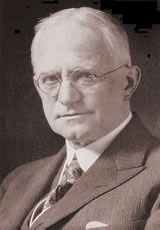 |
1884
GEORGE EASTMAN (1854 - 1932)
Eastman
begins manufacture of rolled paper film in Rochester, New York,
the permanent home of the future Eastman Kodak Company. He applies
for a patent on a film-stripping process, which requires a tougher
outer coating to be peeled off before use. The paper base of film
was coated with a layer of soluble gelatin and on top of this was
again a thin layer of collodion with a light-sensitive gelatin emulsion.
The film is known as Eastman American.
George
Eastman 1854-1932 |
|
|
| |
|
|
| |
|
|
| |
|
|
|
| |
|
|
|
| |
1884
EADWEARD JAMES MUYBRIDGE (1830 - 1904)
One
of Muybridge's busiest years came in 1884 as he produced more than
100,000 plates of humans and animals in a countless variety of motions.
His work was conducted now at the University of Pennsylvania with
a number of different set-ups; three batteries totaling twelve cameras;
forty cameras equipped with a Dallmeyer lens and
electro-magnetic shutter. By now, Muybridge was using the newer
gelatino-bromide plates. By the end of 1885, Muybridge had spent
over $30,000 in research. The work was published as Animal
Locomotion; An Electro-Photographic Investigation Of Consecutive
Phases Of Animal Movement. It had a chrono-text by a physiologist
of the University. |
| |
|
|
|
| |
|
| Muybridge‚€™s
photo-plates ranged in size from 12 x 9 inches to 6 x 18 inches.
The eleven folio volumes contained over 20,000 images of men and
women (some nudes), children and animals and sold for $600. A considerable
amount at the time which therefore constricted its market to libraries,
universities and scientists for the most part. Muybridge reduced
the cost and content of the original work in 1898 to $100 with only
the most important plates and photographs included. Two volumes,
Animals In Motion and The Human Figure
In Motion were sold. |
|
|
| |
|
|
| |
|
|
| |
|
|
|
| |
|
|
|
| |
1884
OTTOMAR ANSCHUTZ (1846 - 1907) |
|
|
| |
Anschutz continues to
take Chronophotographs at the rate of 24 per second using
his own camera design. He used for the most part, animals in motion. Anschutz
photographed sequence, as did Muybridge, and within two years would be
using banks of between twelve and twenty-four cameras to gain his series.
His Tachyscope projected the finished work. SEE
ANSCHUTZ 1887 |
|
| |
|
|
|
| |
|
|
|
| |
|
|
|
| |
|
|
|
| |
|
|
|
| |
|
|
|
| |
|
|
|
| |
|
|
|

|
| |


